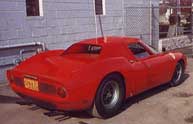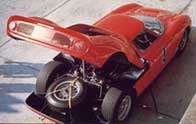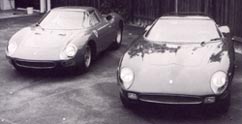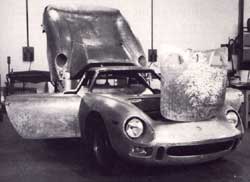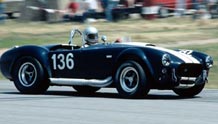|
Old Warriors Ferrari 250 Le Mans Berlinetta Affectionately
called the 'Old Shoe' by its lovers and meant to replace the
aging GTO 250, LM 250 was also called a 250 P with a
roof. A Ferrari first to boast a 3.0 liter (initially)
V12 sitting a few inches away at the rear from the driver. Some how
a Ferrari doesn't seem to be Ferrari if it doesn't boast a
V12. Ferrari
250 LM Berlinetta |
|
|
The Dino chassis was marginally lengthened, the old robust and trustworthy GTO 250 V12 engine was shoehorned in the rear which was designed by Ing. Gioacchino Colombo in 1946. At birth with 1.5 liters and 95 BHP, this engine had grown to 3 liters with an output of 300 B HP. The engine block came in Silumin with steel cylinder liners, The Testa Rossa cylinder heads were mounted at 60 degrees angle with one overhead camshaft for each. A six twin choke Weber 38DCN carburetor was mounted between the heads and dry sump lubrication was fed by a 15 liter oil tank. |
|
|
|
|
A non
synchronized 5 speed gear box in one unit with the differential, was
mated to a GTO 250 V12 engine at the rear. Two 65 liter fuel tanks
were mounted just in front of the rear wheels. Length was 4090mm,
wheel base was 2400mm, breadth was 1700mm and standing 1115mm tall,
made this a relatively small car. The dry weight was 850kgs and the
factory claimed a top speed of 295 kms/hr. |
|
|
250LM was sleek, fast, mid engined and thoroughly reliable. It was one of those cars that people can bet on, without giving much thought. But 250LM did have some tough rivals in the form of Shelby Cobra and Ford GT40. Both these cars were legends in their own right and could not be taken lightly. In April 1964 Ferrari applied for homologation with FIA , but FIA decided against this as the minimum quota of 100 cars were not met. Enzo even maintained that 250LM was a modified GTO250 of which 100 cars were already built. The trouble started after Dr. Carroll Shelby protested heavily that a minimum 100 cars were not built which restricted 250LM to prototype category for which it wasn't designed. The car was extremely agile and fast very much in tradition with conventional mid engined cars. |
|
May 1964 was
the time when 250LM was finally brought out with a definite version.
The rear air intakes were enlarged and placed higher no longer
feeding air to the carbs but for cooling the rear brakes. The
exhaust pipes were modified to 4 and instruments were placed
vertically rather horizontally. In 1964 LM entered 35 races of which
won 10. LM driven by Roy Salvadori beat Mike Salmon's Aston Martin
on 19th of July in the Scot Brown Memorial race at Snetterton.David
Piper won a 9 hour race at Kyalani with Tony Maggs and in Angola GP
Mairesse and Bianchi stood 1st and 2nd Places. A win at Elkhart Lake
in USA and many more club and hill climb races.Count Volphi of
Serderia Serenissima fame also had the LM rebuilt with left hand
drive and, plastic rear window, air conditioning and a special roof
so that Volphi somewhat small in stature could easily enter the car. |
|
This was a
sign of protest by Enzo Ferrari who did not agree with the
organizers who had decided to include Appendix C cars with their big
American Engines. Seven of the nine cars finished the race, the
Piper/Maggs LM at 3rd position behind a Chaparral and Ford
GT40.The gear box and wheel were always a weak point in LM.
Finally in 1965 NART entered Ferrari 250 LM driven by Gregory and
Rindt won the race in front of LM driven by Dumay and Gosseli at
Lemans. Dumays car was leading the race from the 11th hour but
shortly before the end of the race a tyre blew, damaging part of the
body. The repair took such a long time and the lead was lost to NART
entered LM. Another LM driven by Bianchi and Salmon was 6th for the
first few hours but the gearbox started to malfunction, forcing them
to retire around midnight. |
|
|
SEFAC brought
two 330 P2s for Surtees/Scarfiotti and Parkes/Guichet, one 275 P2
for Bandini/Biscaldi and 1.6 liter Dino for Baghatti/Casoni.
Marcello Concessionaires had entered with a 365 P2 for
Bonnier/Piper. A 250LM for Biandi/Salmon. North America Racing Team
(NART) had a 365 P2 for Rodriques/Vaccarella and a LM for Masten
Gregory and Jochen Rindt. Two LMs were entered by Dumay for
Dumay/Gosselin and Scuderia Filipinetti for Boller/Spoerry. |
|
Just
before midnight Surtees came back with a broken spring and 10
minutes after midnight Bonnier/Piper returned with a broken exhaust
mainfold. The tension mounted in the Ferrari pit at 1'oclock in the
morning when the drivers of P2 cars which were mounted with new type
of brakes with radial ventilation slots started complaining about
brake malfunction. By the 11th hour of the race the LM driven
by Dumar/Gosselin was heading the race. In the 17th hour due to a
faulty transmission the P2 driven by Bandini/Biscaldi had to call it
a day and depart. In the GT class Ferrari 275GT driven by
Mairesse/Bourlys was way ahead of the rest. Dumay/Gosselin had been
heading since the 11th hour of the race, but on a straight drive,
one of its tyres exploded damaging part of the body. Gosselin
returned to the pits to replace a tyre and lost the lead to another
LM driven by Rindt/Gregory. This car which had been following
Gosselin's LM for a long time took over and finally finished the
race. The second LM was only 75kms behind. The Filipinetti LM stood
6th. Finally Ferrari won the Le Mans with 1-2-3-6-7 with two
Porsches in between. Rindt/Gregory covered 4677kms in 24hrs at an
average of 195km/hr.
|
|
|
|
|
|
Site
best viewed in 800 X 600 screen resolution |
|
